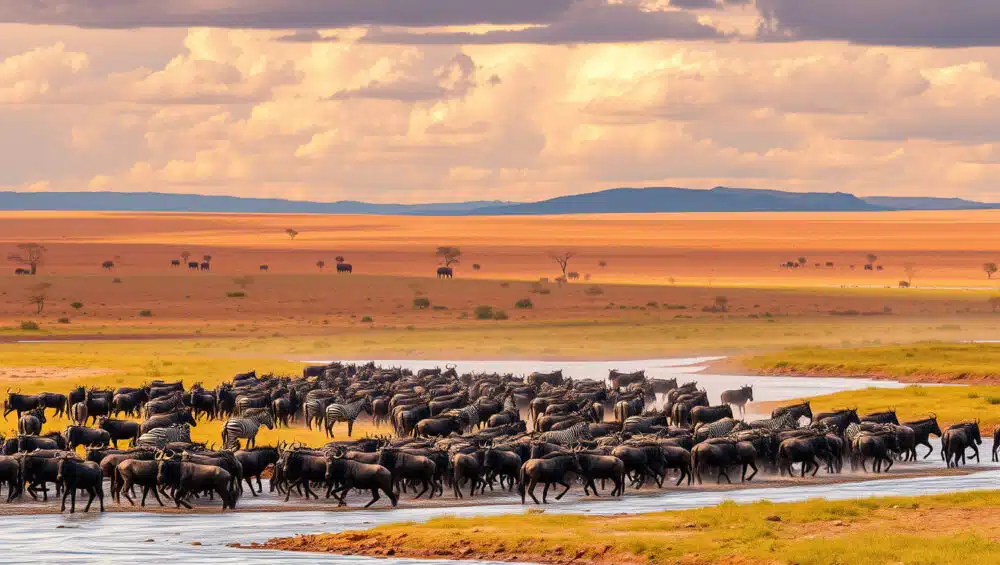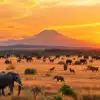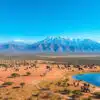Every year, one of nature’s most spectacular events captivates the world: Kenya’s Great Migration. This awe-inspiring journey sees millions of wildebeest, zebras, and other wildlife traversing the plains of East Africa in search of fresh grazing grounds and water sources. Traveling through iconic parks such as the Serengeti and Maasai Mara, the migration showcases the raw beauty of wildlife and the extraordinary cycles of nature. In this article, we will delve into the timing of this breathtaking migration, the key locations to witness it, the wildlife involved, tips for travelers, and the vital conservation efforts that protect this remarkable phenomenon.
Join us as we explore ‘Kenya’s Great Migration – When and Where to See It’ to ensure your next adventure is unforgettable.
Key Takeaways
- The Great Migration in Kenya is a spectacular event involving millions of wildebeest and zebra.
- The migration typically occurs between July and October, with peak moments varying each year.
- Key locations to witness the migration include the Maasai Mara National Reserve and the Serengeti National Park.
- Travelers are encouraged to follow best viewing practices to minimize disturbance to wildlife.
- Conservation efforts are essential to protect the migrating species and their habitats for future generations.
Introduction to the Great Migration
The Great Migration is a spectacular natural phenomenon that draws travelers from all corners of the globe to witness one of the most breathtaking wildlife events on Earth. Occurring annually, Kenya‘s Great Migration involves millions of wildebeest, zebras, and other grazing animals as they traverse the Serengeti in Tanzania to the lush plains of the Maasai Mara in Kenya. Typically spanning from July to October, this migration not only showcases the resilience and instinctual behavior of these magnificent creatures but also presents an unparalleled opportunity for wildlife enthusiasts and photographers alike. In this article, we will explore when and where to see Kenya’s Great Migration, ensuring you make the most of this remarkable adventure.
Timing: When Does the Migration Occur?
Kenya’s Great Migration is a spectacular natural phenomenon that draws thousands of visitors each year, offering a unique opportunity to witness one of the most breathtaking wildlife events on the planet. This incredible migration typically occurs annually between July and October, when millions of wildebeest, zebras, and other herbivores traverse the Serengeti in search of fresh grazing grounds, making their way into Kenya‘s Maasai Mara. The exact timing can slightly vary depending on the seasonal rains and grass patterns, so it’s advisable for travelers to monitor these conditions for the best experiences. During this period, the Mara River becomes a hotspot for action, as herds confront the perilous task of crossing it, often encountering crocodiles and other natural threats. If you’re planning a trip, understanding Kenya’s Great Migration – when and where to see it – is essential for maximizing your safari adventure.
‘In every walk with nature one receives far more than he seeks.’ – John Muir
Key Locations to Witness the Migration
One of the world’s most extraordinary wildlife spectacles is Kenya’s Great Migration, a breathtaking journey that takes place annually between July and October. To fully experience this phenomenon, it’s essential to know the key locations to witness the migration at its most magnificent. The Maasai Mara National Reserve is arguably the best place to see the migration in full swing, as massive herds of wildebeest and zebras cross the Mara River in search of greener pastures. Another prime spot is the Serengeti National Park, which is famous for its vast open plains and abundant wildlife. During the migration, many animals graze in the Serengeti before heading towards the Maasai Mara. Additionally, the Ngorongoro Conservation Area provides unique viewing opportunities, allowing visitors to see the dramatic landscape that herds traverse. For those looking to capture this natural wonder, planning a visit during the peak months of August and September will offer the most thrilling moments, making it a once-in-a-lifetime adventure. By understanding Kenya’s Great Migration – when and where to see it – wildlife enthusiasts can immerse themselves in this iconic event and create unforgettable memories.
The Wildlife Involved in the Migration
Kenya’s Great Migration is a breathtaking spectacle of nature that attracts thousands of wildlife enthusiasts and travelers each year. This magnificent event is primarily marked by the movement of wildebeest, zebras, and other herbivores as they journey from the Serengeti National Park in Tanzania to the Maasai Mara National Reserve in Kenya. Typically, the migration begins in late June and reaches its peak around July and August, coinciding with the grasslands of the Mara becoming lush and ready for grazing. During this time, not only can you witness the mass crossings of wildebeest and zebras as they brave the treacherous waters of the Mara River, but you can also see predatory wildlife such as lions, crocodiles, and hyenas poised to take advantage of the weaker members of the herds. With its dynamic scenery and the vibrant display of life, Kenya’s Great Migration is more than just a natural event; it’s an extraordinary reminder of the cycles of life and survival in the wild, making this the perfect time for travelers seeking to experience one of nature’s grandest displays.
Tips for Travelers: Best Viewing Practices
Traveling to witness Kenya’s Great Migration is a bucket-list adventure for many wildlife enthusiasts. To make the most of this awe-inspiring event, it’s crucial to be well-prepared. Firstly, timing is essential; the migration typically occurs between July and October, with the peak crossing of the Mara River happening around July to mid-August. This is when you will witness the dramatic scenes of wildebeests and zebras making their perilous journey across crocodile-infested waters. Secondly, choose the right viewing locations: the Maasai Mara is renowned for offering some of the best vantage points, with numerous safari lodges positioned strategically along the Mara River. Additionally, consider varying your viewing times; early mornings or late afternoons often provide the best opportunities to see wildlife in action. Lastly, remember to engage with knowledgeable guides who can enhance your experience with their insights into animal behavior and ecology. By following these tips, you can ensure a memorable and impactful experience at one of nature’s most spectacular events – Kenya’s Great Migration.
Conservation Efforts and the Future of the Great Migration
Kenya’s Great Migration – When and Where to See It is not just a spectacular natural event; it also sheds light on the vital conservation efforts aimed at protecting wildlife and their habitats. As millions of wildebeest, zebras, and other grazers traverse the plains of the Serengeti and Masai Mara, conservationists work tirelessly to ensure that these animals can complete their journey safely. The migration typically occurs between July and October, offering the best opportunities for wildlife enthusiasts to witness this breathtaking spectacle. Conservation programs in Kenya are focused on habitat protection, anti-poaching initiatives, and community engagement to ensure the long-term sustainability of this phenomenal event. By promoting responsible tourism and education about the importance of preserving these ecosystems, Kenya aims to foster a future where the Great Migration continues to thrive, captivating generations to come.






